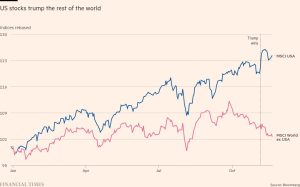US hydrogen industry warns over regulatory limbo
This article is an on-site version of our Energy Source newsletter. Premium subscribers can sign up here to get the newsletter delivered every Tuesday and Thursday. Standard subscribers can upgrade to Premium here, or explore all FT newsletters
Good morning and welcome back to Energy Source, coming to you from New York.
The Federal Reserve cut interest rates for the first time since the pandemic yesterday, signalling the end of its more than two-year effort to tame inflation. The move will probably serve as a boost to the country’s capital-intensive renewables buildout, which has been pummelled by steep borrowing costs that rendered many projects uneconomical, most prominently offshore wind.
Clean energy stocks rallied modestly before and immediately after the Fed’s decision. The Invesco Solar ETF climbed 4 per cent in intraday trading before settling below its previous closing price. The iShares Global Clean Energy ETF rose 2.3 per cent before falling.
The Financial Times has a deep dive into Swedish battery start-up Northvolt’s fight for survival this morning. The company was meant to symbolise Europe’s green fightback against China and the US. Instead, it’s in danger of turning into an emblem of the continent’s failure to stay in the race.
Today’s newsletter checks the pulse of the clean hydrogen sector, which has been slowed down by macroeconomic headwinds and policy uncertainty.
Thanks for reading,
Amanda
US hydrogen industry warns over regulatory uncertainty
Tough macroeconomic conditions and policy uncertainty are putting US hydrogen projects in limbo and the sector at risk of moving abroad, industry members warn.
Jennifer Rumsey, chief executive of Cummins, told Energy Source that lack of final hydrogen tax credit rules in the US have slowed down new equipment orders and timelines for projects in their backlog.
“People are waiting,” Rumsey said, adding that inflation and high interest rates have also challenged projects. “Customers are re-examining, what [do] the economics look like? Can I still afford to invest?”
President Joe Biden’s landmark climate law, the Inflation Reduction Act, offered lucrative tax credits for clean hydrogen, which is hailed for its potential to decarbonise hard-to-abate sectors such as heavy industry. But two years after the IRA’s passage, the tax credit rules have yet to be finalised as a fierce debate rages over the criteria hydrogen producers must meet to claim green subsidies.
“The inability to have regulations which are clear and which are usable has delayed the US market without a doubt,” said Andy Marsh, chief executive of Plug Power. The hydrogen equipment manufacturer is facing a cash crunch and received a $1.7bn conditional commitment in May from the Department of Energy’s Loan Programs office for six US hydrogen projects.
“Back in 2022, everybody in Europe was afraid all the jobs were going to go to America. I think the exact opposite will happen . . . if the US just keeps on going slow,” Marsh said.
Earlier this week, the Hydrogen Council, which includes Plug Power and Cummins, released its annual report on the state of the hydrogen industry. The report, co-authored with McKinsey, found that while $96bn has been committed to the North American sector by 2030, only 18 per cent of the commitments have reached a final investment decision.
The report tracked “renewable” hydrogen projects, produced using renewable electricity, and “low carbon” hydrogen projects, produced using fossil fuels and then capturing the emissions. Uncertainty over regulatory frameworks such as the IRA tax credit was cited as a critical challenge impeding project bankability.
“We’re leaving opportunities on the table in areas where regulation is not clear or missing, or where it is not workable,” said Ivana Jemelkova, chief executive of the Hydrogen Council.
Treasury deputy secretary Wally Adeyemo told ES the department has “talked to a number of companies” that say they will be able to build projects with the help of the rules.
“We are carefully considering the feedback and comments that have come in, and we’re working hard to get the final rules done and to provide certainty as quickly as possible,” Adeyemo said.
The global view
A lack of commitment is widespread across the global hydrogen sector. While the report tracked $680bn in clean hydrogen project announcements through 2030, only $75bn of these announcements have reached a final investment decision. The Hydrogen Council estimates this needs to grow eightfold to remain on track with climate targets.

“We have arrived at a point where hydrogen is embedded in the energy transition and what happens from here is either the energy transition as a whole moves forward . . . or we do not move the energy transition forward,” Jemelkova said.
Brian Murphy, a senior analyst at S&P Global Commodity Insights, agreed with the report’s outlook, saying final investment decisions have been “below the pace required in most net zero scenarios.”
It’s not all doom and gloom. In 2020, the council tracked only $10bn globally in hydrogen projects with final investment decisions. Total investments in hydrogen have since grown seven-fold.

Hydrogen projects are moving the fastest in east Asia, where governments offer strong incentives and targets for the sector. Roughly 73 per cent of hydrogen commitments in Japan and South Korea have reached final investment decisions, and in China, 60 per cent of investments are finalised, compared with the global average of 11 per cent, according to the report.
“A seven-fold increase [globally] over the past four years is significant. However, considering the climate commitments, the pace and scale of deployment have not been sufficient,” Jae Hoon Chang, chief executive of Hyundai and co-chair of the Hydrogen Council, told ES. The auto giant is involved in hydrogen projects in South Korea, Poland and Indonesia and has been an early mover in hydrogen-powered vehicles.
Job Moves
-
Jiri Zrust, head of infrastructure at CVC Capital Partners, is leaving the private equity firm to join Trafigura as global head of operational assets.
-
Thyssenkrupp nucera, a green hydrogen company, has appointed Sachin Nijhawan as US chief executive and Juergen Grasinger as chief operating officer.
-
Jeff Rosenbaum has joined King Street Capital Management as partner, where he will focus on infrastructure, energy and power. Rosenbaum most recently served as president of the direct investments business of NextEra Energy.
-
Gunter Erfurt, chief executive of Swiss solar manufacturer Meyer Burger, is stepping down, along with chief financial officer Markus Nikles. Erfurt will be replaced by executive chair Franz Richter.
-
Pattern Energy appointed Matthew Rhodes as chief financial officer. Rhodes most recently worked at Essential Utilities as an executive vice-president and was a managing director at Goldman Sachs.
-
South African chemicals firm Sasol has named Muriel Dube as chair of its board. Dube previously served as chief negotiator for the government of South Africa in UN climate negotiations.
Power Points
-
Chevron boss Mike Wirth has attacked the Biden administration’s oil and gas policy, saying it was pushing up prices and “undermining energy security” for US allies.
-
Businesses in Pakistan are rushing to install ultra-cheap Chinese solar panels after a surge in electricity prices has made the country’s cost of power among the most expensive in south Asia.
-
The US faces a “Manichaean choice” over climate action in the presidential election, former vice-president Al Gore warns.
Energy Source is written and edited by Jamie Smyth, Myles McCormick, Amanda Chu, Tom Wilson and Malcolm Moore, with support from the FT’s global team of reporters. Reach us at [email protected] and follow us on X at @FTEnergy. Catch up on past editions of the newsletter here.
Recommended newsletters for you
Moral Money — Our unmissable newsletter on socially responsible business, sustainable finance and more. Sign up here
The Climate Graphic: Explained — Understanding the most important climate data of the week. Sign up here
#hydrogen #industry #warns #regulatory #limbo



